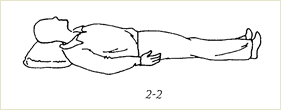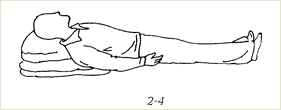Welcome to website of Nei Yang Gong and Tai Ji Quan

Foundation level
There are 3 positions used for practicing Jing Gong at the Foundation level and these are:
Figure 2.2
For High Blood Pressure (HBP) separate the feet to shoulder width while for Digestive disorders place hands on Dantian, elbows resting on the ground.

Zuò 座 (Sitting) Sit on a soft chair with neck and back of waist supported, legs stretched out or slightly bent, arms on armrests, palms facing down (an armchair with a sloping back is better than an upright chair). Where your condition allows, or as you begin to get stronger, you can sit on the edge of chair with both feet on the ground sitting with the spine naturally upright and imagining the point at the crown of the head, Bǎi huì 百会 point, is suspended above by a thread. Figure 2.3
Those with High Blood Pressure conditions should cross their ankles and for digestive disorders hands should be placed on the Dan Tian and for deficient Yang conditions the palms should face up.
Zhàn 站 (Standing) - Stand in Wu Ji stance with your feet about shoulder width apart, arms at the side of your body, fingers dropping down naturally. Back and chest relaxed, knees bent loosely (but not in past toes), space between the upper arms and the ribcage. Chin drawn in slightly to lengthen the back of the neck so that the Bǎi huì 百会 point is pointing to heaven
Intermediate level
There are four additional postures at the intermediate level;
- The Latericumbent lying posture
- The Supine lying posture
- The Sitting posture
- The cushioned lying posture
Generally, the lying postures are first selected at the very beginning though people with relatively good constitution may start with sitting posture.
The cushioned lying posture is particularly suitable for those with poorer health.
The Latericumbent Lying Posture
Lie on bed on either side of the body with the head properly cushioned by a pillow to a bit higher position and slightly flexed. Relax the waist, straighten the underneath leg in a comfortable position with the other leg bent at an angle of 120 degrees resting on the former. Stretch and relax the fingers of the underneath hand which is placed on the pillow in front of the head with the palm facing upward; and put the upper hand on the Ipsilateral hip. Narrow the eyes to allow a little light to penetrate; or completely close the eyes when one has become so skillful that he can easily get into the tranquil state (see Fig. 2-1).

The Sitting Posture
Sit upright on a chair, with one's back not leaning against anything, the neck a bit flexed, the knee joints bent in a right angle, the feet placed on the ground rather than hanging, the arms drooping naturally, the hands put on the ipsilateral thighs and the palms facing downward. Narrow or completely close the eyes as described above in the Latericumbent position.
(See Fig. 2-3).

The Cushioned Lying Posture
This posture is similar to the supine lying posture, but the head and shoulders should be solidly cushioned to as high as 25 cm without leaving any space. The feet are placed close together and the hands put on the lateral sides of the thighs
(See Fig. 2-4).

Breathing
Breathing should be natural and through the nose to encourage a relaxed state. In time the breath will become calm (jing), slender (xi), deep (shen), continuous (you), slow (man) and even (yun). The abdomen moves out on the in breath to draw in qi and relaxes back in on the out breath. Once abdominal breathing becomes natural, reverse breathing can be practised (abdomen draws in on the in breath and relaxes on the out-breath). In reverse breathing qi sinks to the Dan Tian like a stone to the bottom of the sea. Reverse breathing helps to open the Ren Channel Qi and blood circulate in the abdomen – a warming practice.
